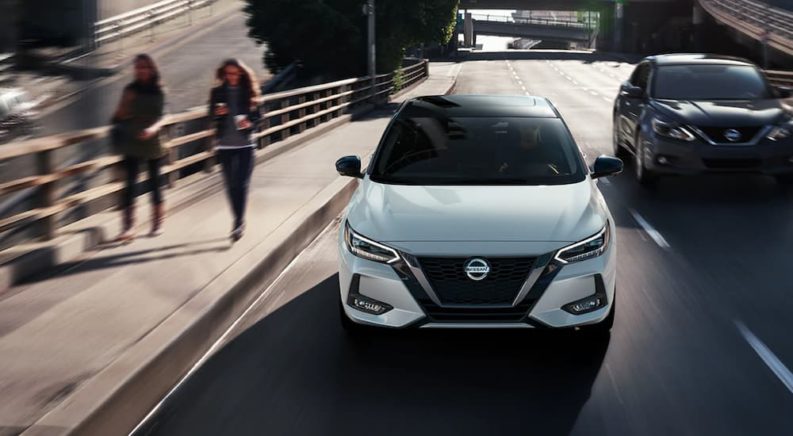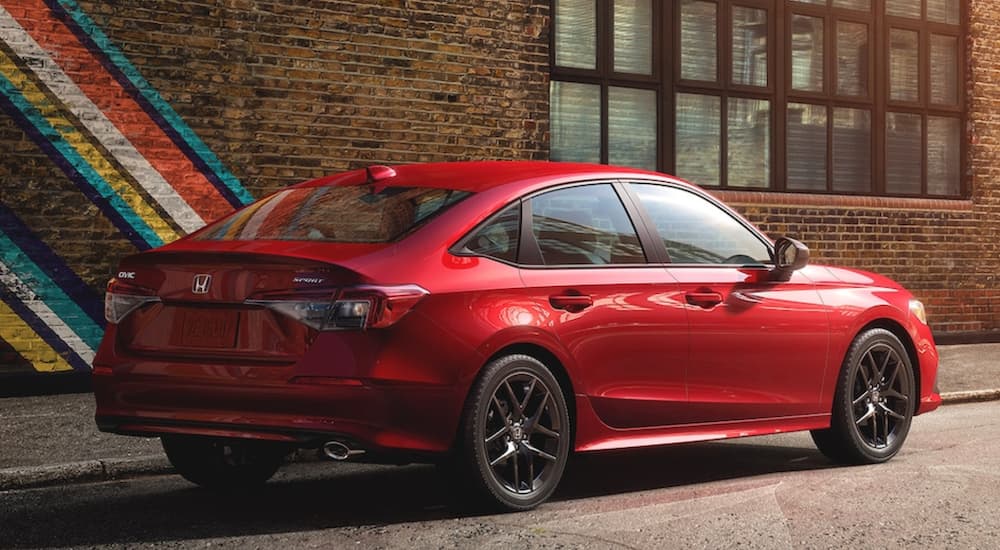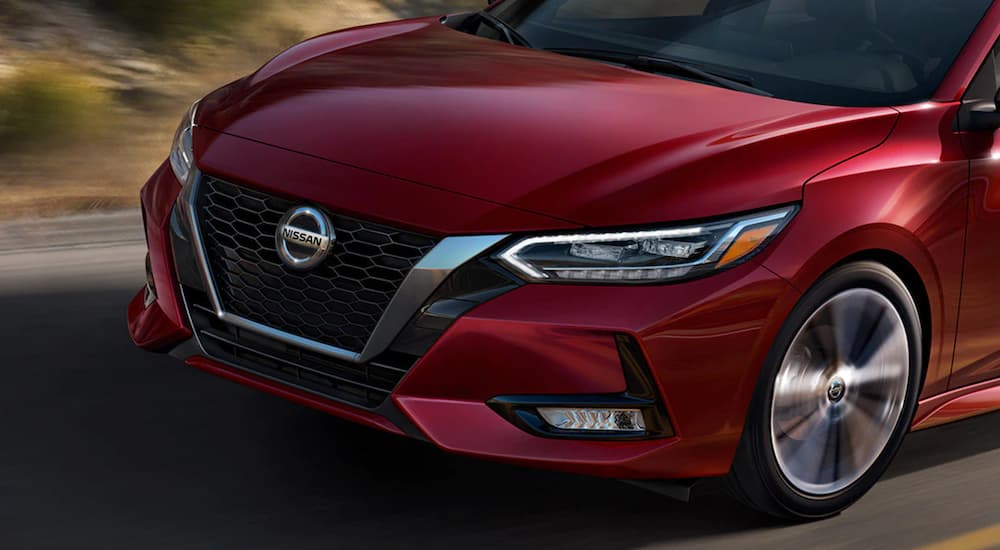Out of a flock of compact cars, few stand out as being truly fun, exciting, or inspiring to drive. Two sedans worth a serious look are a pair of heavy hitters who have been around the block a number of times, with the 2021 Nissan Sentra now in its eighth generation and the 2021 Honda Civic at the end of its tenth. Strong styling, comfortable interiors, and generous safety features adorn each of these compact sedans. The Sentra is one of Nissan’s best-selling vehicles, and Honda lays claim to a best-selling status with the Civic, too. If you’re in the market for a compact sedan, the 2021 Nissan Sentra vs 2021 Honda Civic may give you food for thought about which sedan to buy.
Features both sedans share include standard 2.0-liter inline-four engines, and both are available only with front-wheel drive. A continuously variable transmission pairs with both engines, though the Honda has the option of a six-speed manual transmission. Fuel efficiency is about the same, with the Sentra getting 29 MPG city and 39 MPG highway, and the Civic coming in at 30 MPG city and 38 MPG highway with its 2.0L engine. Both cars ride on 16-inch wheels, with the option for larger wheels in upper trims.
Pricing begins at $19,460 for the 2021 Sentra at entry level, and the Civic pricing begins at $21,250. One consideration to point out with pricing is that the Civic price, already higher than the Sentra at its least expensive, does not come with much at entry-level, and most buyers will likely want to opt for a higher-level trim.
Exterior Styling and Conveniences
When it comes to style, you can’t go wrong with either of these compact sedans. Despite being near the end of a generation that hasn’t been revamped since 2016, the Civic is still an attractive vehicle with slick fastback shaping to its design and unique taillights that stand out on the road. It’s unfortunate Honda has chosen to shut down production on the coupe-style Civic, which had a sportier vibe, and for 2021 the Civic Si is also not available. On the other hand, Nissan keeps things simpler with the Sentra by offering it with one sporty style across its trims, its refreshed design now exhibiting the same V-motion grille as other vehicles in the Nissan lineup, and its sculpted hood and sides are sleek and modern. In addition, Nissan gives the Sentra trendy floating pillars and the option for a black roof in the SR trim.
Conveniences like keyless entry and push-button start are often an expected feature these days, and Nissan thoughtfully provides them at entry level for the Sentra. Honda’s base trim is fairly bare minimum and doesn’t offer this convenience until the second-tier Sport trim. LED headlights are another feature buyers are excited to have, but both brands make buyers wait until the uppermost trim to gain access to this option. Fortunately, both Nissan and Honda are focused on safety features, so they provide automatic high beams as standard across all trims. Exterior mirrors come powered at entry-level, and the option for heated mirrors is available in upper trims in both vehicles. Generally, features are virtually equal except for the keyless entry afforded to the Sentra. Let’s face it, who doesn’t want a push-button start?
Interior Convenience and Comfort
Most buyers in this segment are looking for a vehicle they plan to drive for commuting or travel, which often means long drives. When you spend hours in your vehicle every week, you want comfortable seats and a few extra features to help pass the time. It’s worth mentioning right off the bat that Nissan offers sumptuous quilted leather seats if you go for the upper trim, an unexpected delight to find in a compact car. Thankfully, gone are the days when we were forced to listen to whatever was playing on the AM/FM radio stations; with smartphones in every pocket, we all expect to be able to pair our phones with the infotainment so we can have our own music and content piped through the stereo system.
Any vehicle not offering standard Apple CarPlay and Android Auto is behind the curve. Enter the Honda Civic, which still does not offer this feature on the base model in 2021. Seriously? For the higher price, this should be standard. Thankfully, Nissan gets the importance of technology as a central aspect of life for most people and gives smartphone owners this feature. What’s more disappointing is the sad, small screen you find in the entry-level Honda. A five-inch infotainment screen is all she wrote, a laughable size in comparison to the much larger seven-inch screen in the Nissan. You do at least get Bluetooth as standard for both sedans, which allows for streaming and hands-free phone use. That’s about all you get for the Civic infotainment at base-level pricing.
Other aspects of the interior for both sedans make each compact fairly comfortable for driving. Nissan gives the 2021 Sentra lots of soft-touch materials for an upscale feel, and those zero-gravity front seats are extra comfy for long drives. Honda also provides excellent front seats with plenty of room and materials in an upscale manner. The space inside each vehicle is fairly comfortable in the rear seats as well, though the Honda does provide more leg room for the rear passengers. Trunk space is about the same for each sedan, and they both offer rear folding seats to expand for larger cargo. For the money, however, the Nissan offers more access to technology at its base price, and those zero-gravity seats really are amazing.
Driver-Assist Safety as the Standard
Honda is known for its standard of safety across the board. It’s part of the reason buyers were attracted to the brand when it started gaining a larger customer base, and Honda certainly delivers on driver-assist tech right from the entry-level trim. Now that Nissan is a rising star in the car industry, this brand is also gaining ground with its attention to safety as a hallmark of its tech-focused marketing. It goes without saying that Honda’s Safety Sense suite of driver-assist tech is generous indeed, and it covers all the basics. On the other hand, Nissan is taking those standard safety features and upping the ante with a little extra coverage most brands are not offering at base-level pricing, and it’s doing so for a lower starting price.
First, let’s look at the comprehensive Honda technology. It’s a big deal that Honda provides Adaptive Cruise Control for the entry-level, and it also gives buyers another desirable feature with the Road Departure Mitigation System. Both of these features reduce fatigue on long drives to make them more tolerable. In comparison, Nissan’s big-ticket items include features that truly make your life easier, like the Rear Cross Traffic Alert with a rear sonar system. When you’re backing out of a driveway or parking spot, this is gold if you don’t happen to see another vehicle coming your way. You do have to wait until the second trim to gain the Intelligent Cruise Control with the 2021 Sentra, but it’s there in the lineup along with the Rear Automatic Braking, which isn’t offered on the Civic at all.
Most of the other tech features like forward collision warnings, automatic emergency braking, and lane-keeping are there for both brands, including several behind-the-scenes electronic features like stability and traction control. One feature that serves drivers on long commutes or travel days in the Nissan suite, however, is the intelligent driver alertness system that monitors the driver for signs of fatigue. If you seem like you’re sleepy or having trouble paying attention to the road, the warning will show on your dash in the form of a cup of coffee to suggest pulling over for a break. In addition, Nissan provides a special feature for rear passengers, specifically aimed at children. The rear door alert will keep the back door locked until the rear sonar senses there is no traffic, which can save a child from opening a door into a busy street.
Sentra or Civic? You Decide.
The 2021 Nissan Sentra starts at a lower price than the 2021 Honda Civic, and after delving through several noteworthy features, it’s clear the two sedans are well-matched. In some respects, each sedan has its strengths over the other, factors which may boil down to personal preference. What can’t be denied is the difference in savings with the Nissan, regardless of the trim level you buy. Even if you purchase the most expensive Sentra trim at its MSRP, it beats the second-tier trim of the Civic, where you only begin to gain some of the features you get at the base level in the Nissan. For this reason alone, the 2021 Sentra is a far better buy and worth a test drive if you plan to purchase a compact sedan in 2021.






